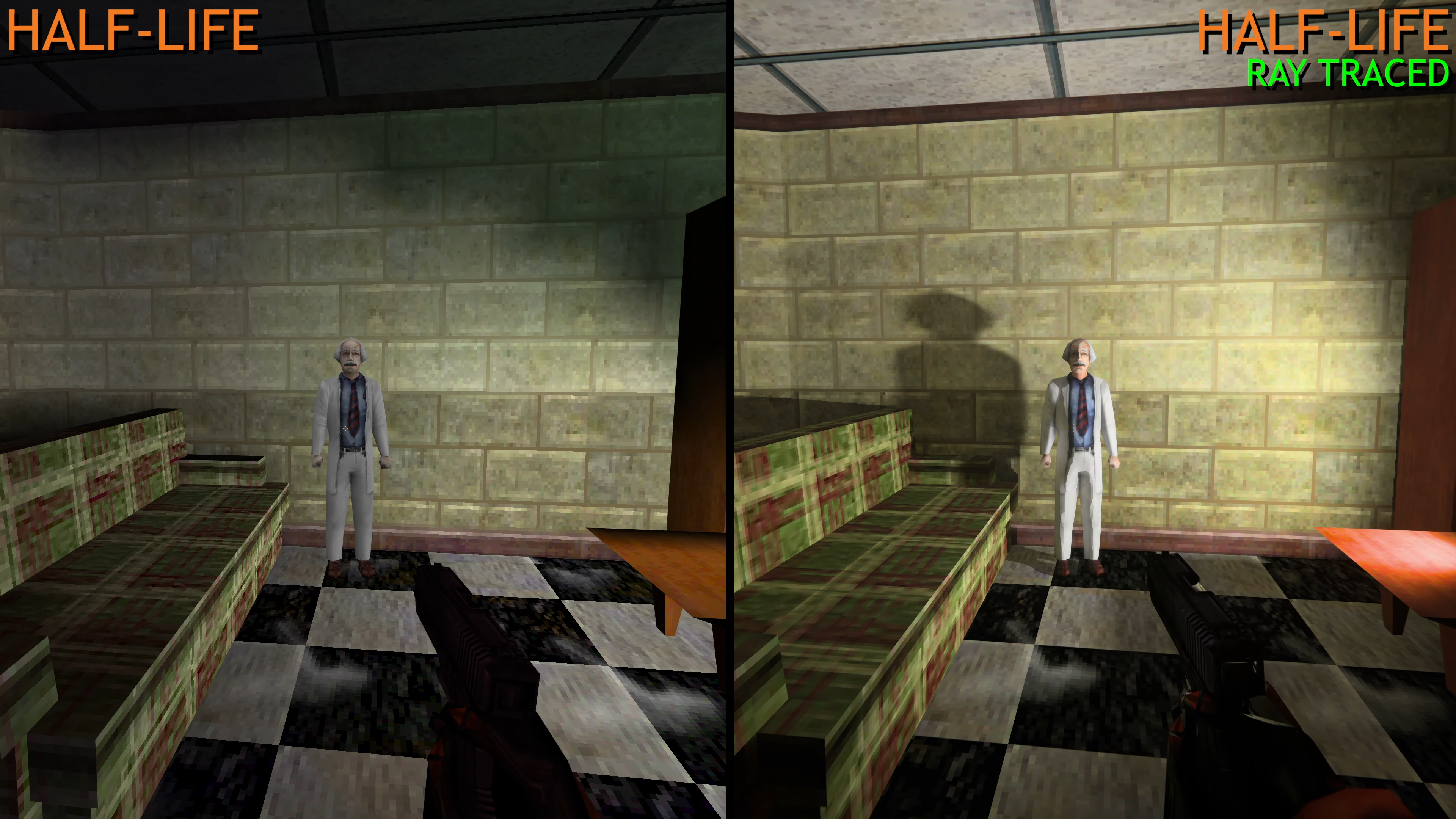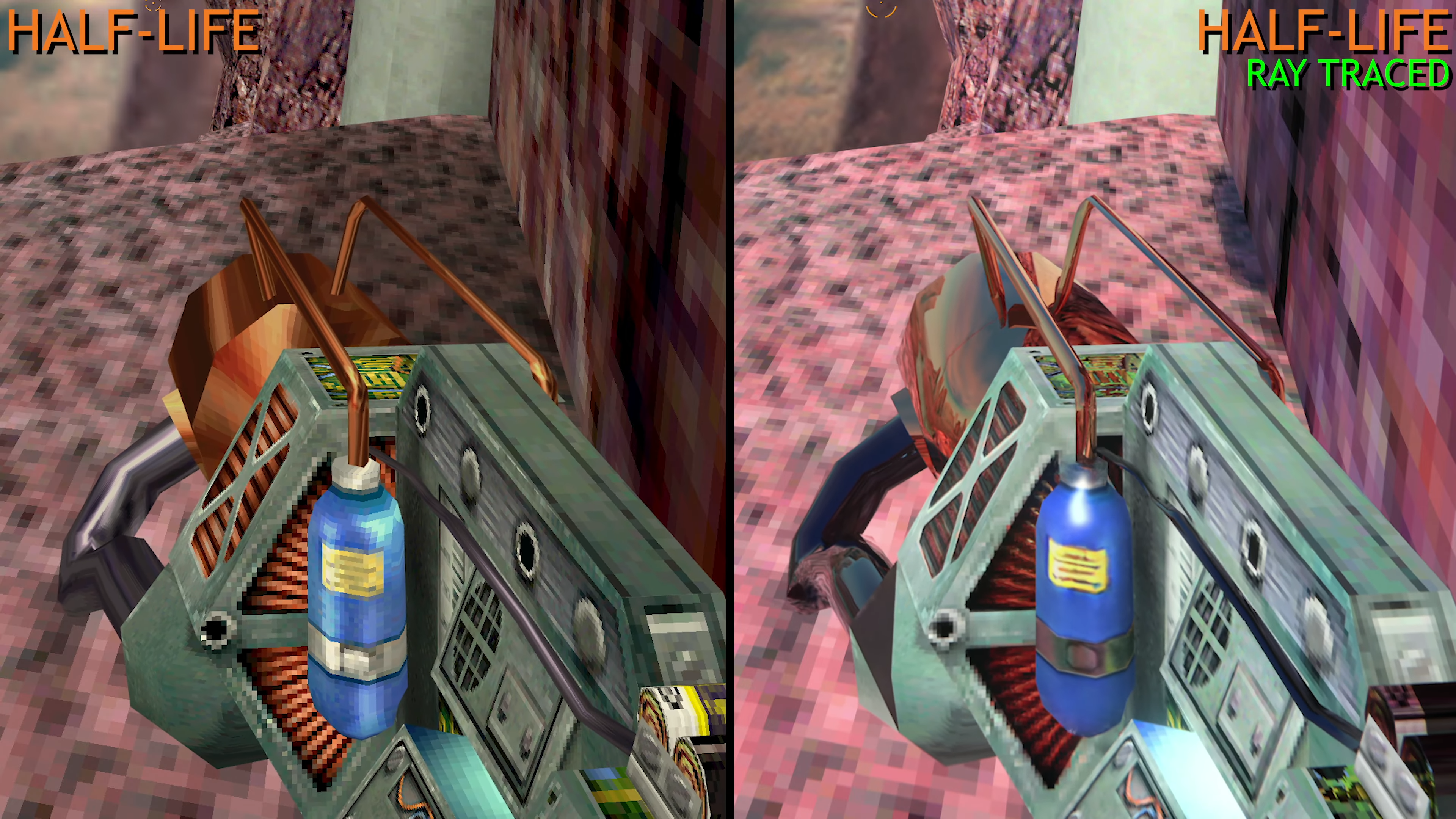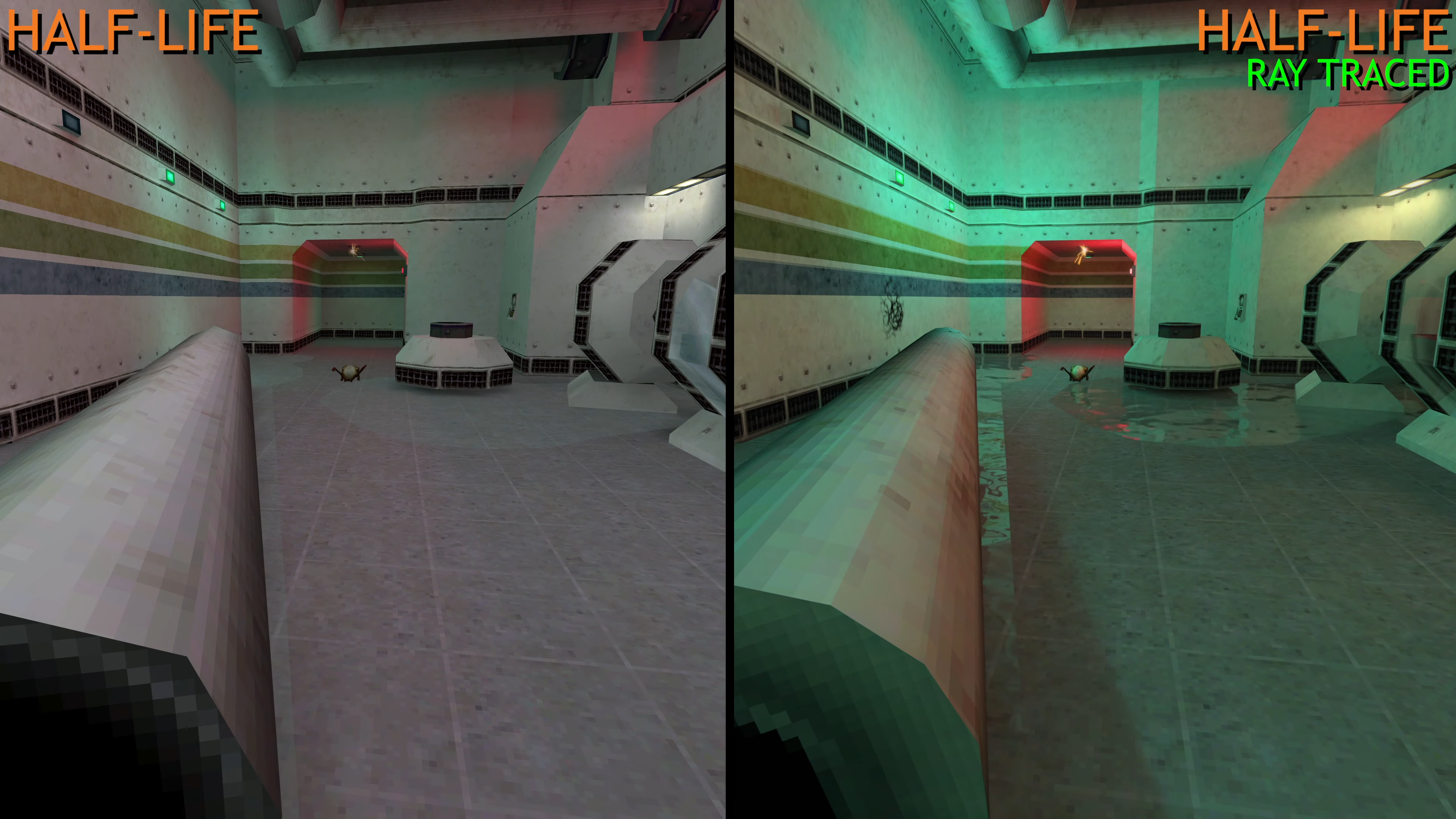Half-Life is one of the most influential games of all time, not only thanks to its immersive setting, story, and graphics, but also because of its “moddability.” Long after most people had played through the campaign, games and mods powered by the GoldSrc engine continued to entertain and amaze us. Almost 25 years after its release, a new mod for Half-Life has arrived: a fully ray-traced version of the game, thanks to modder Sultim Tsyrendashiev, who previously produced ray-traced versions of Serious Sam, Doom, and Quake.
The mod completely redesigns the in-game lighting using path tracing while preserving the assets, thus offering an alternative vision of a modern day Half-Life compared to the fan-favorite Black Mesa remake. It’s a transformative upgrade to behold, so we played the RT version to examine what exactly the mod does, how it compares to the 1998 original, and how well it runs on modern graphics cards.
Fortunately, set-up is straightforward – just install Half Life on Steam and then load the required files from Sultim’s Github pageby following the instructions there.
Manage cookie settings
Interestingly, Half-Life RT is a derivative of Xash3D rather than GoldSrc, an open source 3D engine that has excellent compatibility with GoldSrc assets. The RT version builds on that by replacing the rendering part with a Vulkan driven path tracer. Almost all artworks, textures and models are the same; the main difference is mainly how these objects are lit and shaded.
Looking back at the original, it was designed with the CPU, GPU and RAM limitations of the time in mind. Because of this, real-time lighting was minimal and limited to the game’s rarely used flashlight. Most of the lighting was calculated offline and then projected onto the world using textures. Usually static, but occasionally they’ve been toggled on and off or quickly swapped around to give the appearance of dynamic lighting. In general, the light maps show light emanating from the sun, lights and other logical light sources, and even bounce lighting is used to achieve realistic results.
Valve’s attention to detail in lighting consistency means the game still looks reasonable in 2023, but it also means the game lends itself to path-tracing conversion in an almost unique way.
For the RT mod, Sultim made sure the lighting came in the same style and intensity from the same light sources of the original game. As a result, the path-tracing lighting moves incredibly close to the original – only with more detail and – more importantly – dynamics.

For example, the original contained office lamps that cast colored light on their surroundings in the way you would expect. In the RT remake, you get near-identical coloring and direction, but now the lighting is pixel-perfect, fully dynamic, and no longer a low-res static texture. When a scientist walks in front of the lamp, they now get an appropriate shadow. There is a similar but more dramatic effect with light emanating from fan blades spinning behind, which now cast a moving shadow into the room and onto themselves. In the original, there was often a marked contrast between characters and their surroundings due to differences in lighting between static and dynamic objects, but now both categories feel like they’re equally anchored in the game world.
As mentioned above, bounce lighting was present in the original, but the number of objects included and their overall quality was limited by the realities of costly offline render time. This means the RT version dramatically improves bounce lighting, resulting in more realistic results, with light bouncing multiple times to spread around the scene. For example, this makes the blue color of the sky more obvious to affect the hue of shaded regions and provides a more visually striking look with more obvious direction in scenes that are heavily lit from a single source, such as a street. B. Rooms with skylights. As the direction and intensity of the global lighting effects are much more pronounced, we also see changes in smaller interior areas – even a small light fixture on a wooden desk can paint an entire room a russet hue if it’s the only light source in the area.
Emissive light sources are handled beautifully here too, with toxic waste pools giving off a frightening ambient glow without the light leaking or oddities with moving objects that you would notice in the original. Sultim also uses these light sources to replace the rare instances of “fake” lighting from the original, lighting up pipes with a toxic sludge puddle. I like how this fits with the Half-Life theme while still allowing the physically plausible path tracing to work its magic.


.png/BROK/resize/690%3E/format/jpg/quality/75/Half-Life_-A-Full-RT_Path-Traced-Upgrade-For-The-OG-PC-Classic-Tested!-12-31-screenshot-(1).png)
In addition to recreating lighting in real-time with greater accuracy, RT Path Tracer also adds reflections on objects that have glossy textures in the original, such as the Colt Python revolver, Gordon’s HEV suit, or Barney’s helmet. Gordon’s Legendary Crowbar is also significantly shinier and also more geometrically complex. There are also more subtle changes, such as making the metal tips of shotgun cases more reflective than the matte box they come in, or replacing hand-drawn reflections with physically accurate reflections on some weapon models. Aside from metals, water and glass now produce realistic, perspective-correct reflections and refractions.
The RT mod adds illuminated fog on top of that, something Half-Life’s contemporaries like Unreal used but Half-Life didn’t. For example, the rays of light visible in the train ride at the beginning were created by hand-placed transparent geometry. Now the game uses a “per-light ray-marched” approach, which produces obvious rays of light that both replace existing rays of light and add technology to scenes that didn’t have them – often to dramatic effect. This is one of the more obvious artistic changes from the original, and a pleasant surprise as it must have taken a very long time to add this for each scene.
Finally, the path trace renderer includes some subtle post-processing like bloom that can be adjusted in the graphics options menu. It’s also possible to change more complex variables like sky intensity, water color, and volumetric lighting in the console or via an autoconfig file, allowing the game to look how you prefer if the default settings aren’t enough for you. You can even render the game with classic lighting, which retains all of the new reflections from the path trace renderer, but removes all of the new additions to lighting, volumetrics, and more. So if you don’t like these new additions, you can still play Half-Life with some modern ray tracing benefits.


.png/BROK/resize/690%3E/format/jpg/quality/75/Half-Life_-A-Full-RT_Path-Traced-Upgrade-For-The-OG-PC-Classic-Tested!-14-4-screenshot-(1).png)
As for performance, FSR2 and DLSS are the only real ways to improve it. It’s just a mod and not a full game, so there aren’t any settings you can adjust outside of these upscalers. BTW, I don’t recommend using the version of DLSS linked on the Github page, as it’s a “standard” version that seems to lead to ghosting. Instead, you should use version 2.5.1, which is based on the Techpowerup DLSS download page is available.
Nvidia GPUs have an advantage here in terms of frame rate due to their more advanced ray-tracing hardware acceleration, with my testing showing an RX 6800 XT delivering around 60 percent of the performance of an RTX 3080. To achieve 4K 60fps on this hardware you need to use DLSS quality mode (Nvidia) or FSR2 performance mode (AMD). For lower-end hardware like the RTX 2060, you can use DLSS quality mode to achieve 1080p60. Unfortunately, the game does not currently start with an Arc A770 if you are one of those with Intel hardware.
Ray-traced Half-Life is a superb remix of the visual design of this classic game, showing Sultim’s dedication and attention to detail throughout the mod. This release is more than a good reason to play the original again.
Originally written by Alex Battaglia, Video Producer, Digital Foundry
